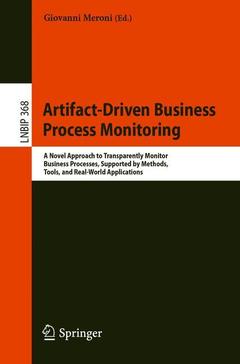Description
Artifact-Driven Business Process Monitoring, 1st ed. 2019
A Novel Approach to Transparently Monitor Business Processes, Supported by Methods, Tools, and Real-World Applications
Lecture Notes in Business Information Processing Series, Vol. 368
Author: Meroni Giovanni
Language: English
Subject for Artifact-Driven Business Process Monitoring:
Approximative price 52.74 €
In Print (Delivery period: 15 days).
Add to cartSupport: Print on demand
Description
/li>Contents
/li>Comment
/li>
This book proposes a novel technique, named artifact-driven process monitoring, by which multi-party processes, involving non-automated activities, can be continuously and autonomously monitored. This technique exploits the Internet of Things (IoT) paradigm to make the physical objects, participating in a process, smart. Being equipped with sensors, a computing device, and a communication interface, such smart objects can then become self-aware of their own conditions and of the process they participate in, and exchange this information with the other smart objects and the involved organizations. To allow organizations to reuse preexisting process models, a method to instruct smart objects given Business Process Model and Notation (BPMN) collaboration diagrams is also presented.
The work constitutes a revised version of the PhD dissertation written by the author at the PhD School of Information Engineering of Politecnico di Milano, Italy. In 2019, the PhD dissertation won the ?CAiSE PhD award?, granted to outstanding PhD theses in the field of Information Systems Engineering.
Revised PhD dissertation
Received the CAiSE PhD award for an outstanding thesis in the field of Information Systems Engineering
Proposes a novel technique which allows to monitor multi-party processes, involving non-automated activities

